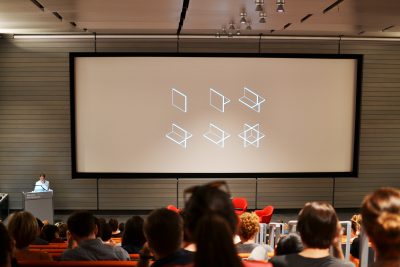
The latest event in a series of urban studies investigations, “Telling Traces: Moving through the City in Lit., Film, and Art” took place on Saturday at the Harvard Art Museums in Cambridge. Hosted by the Harvard Mellon Urban Institute with funding from the Mellon Foundation, the exhibit served as conversation between major influencers in visual art, architecture and media.
Through these viewpoints, panelists and audience members exchanged ideas exploring how the intrapersonal experiences of a city influence its design.
In the basement of the museum, academics from universities in the Boston area gathered for the event, eagerly awaiting the first words of Erik Ghenoiu, the research manager of the Harvard Mellon Urban Initiative and curator of the exhibit.
Ghenoiu explained the importance of telling a city’s story through “the extension of viewpoints, not only through human eyes.”
“Today we are telling the story of the city — the built space, not through the grand stones but the little traces and ordinary experiences,” Ghenoiu said.
The afternoon divided the topic of the city into two parts: art and technology.
Giuliana Bruno, a professor of visual and environmental studies at Harvard University, moderated the panel of artists, consisting of writer Suketu Mehta and visual artists Ann Hamilton and Sarah Oppenheimer.
Mehta read his most recent published work, “Queens of the Stoned Age,” found in this March’s issue of GQ, in which he profiled the Green Angels, a group of ex-models turned high-end weed dealers.
Mehta went on to explain how writing about this unofficial economy (marijuana was still illegal in New York at the time of this article) describes how movement and behavior are affected by the environment they are placed in.
This theme carried over into the second half of the event with author Geoff Manaugh and his new book, “A Burglar’s Guide to the City.” Despite the name, the book is not an instruction manual to breaking and entering. Rather, Manaugh has written the biography of burglary, a crime that he argues is a byproduct of having cities.
“Criminality has a three-dimensional relationship with the environment,” Manaugh said. “It sees things that law-abiding citizens don’t.”
He then proceeded to tell the unsolved crime story of a 1980s burglary, one that involved individuals who used the city sewer system to burrow underground and rob two banks in Los Angeles.
“Burglars pass through the built environment like ghosts seeking entry along lines the architect had not anticipated,” Manaugh said.
This ability to take advantage of the overlooked infrastructure and barriers, Manaugh said, is what makes burglars “masters of architecture” by revealing the three-dimensionality of cities.
The theme of city barriers was also seen in the conversation between artists Hamilton and Oppenheimer. Oppenheimer, whose work Bruno described as “architecturally mesmerizing,” creates visual art through the manipulation of mirrors, glass and angles creating or misrepresenting barriers in space.
“The potential in a material in something like glass is its transparency,” Oppenheimer said. “You can manipulate it, make it more opaque or reflective but its most distinguished feature is its transparency.”
In contrast, Hamilton, who earned her bachelor in textiles, uses sound and touch to manipulate the senses, or the “apertures” of a space. Best known for her work with Park Avenue Armory, Hamilton works with ordinary objects to create her pieces.
To transform the military space of the Armory into a communal playground, Hamilton split the room using a massive cotton curtain attached to wooden park swings that manipulated the movement of the curtain up and down. There were no instructions.
“The armory was a built space for the public to respond to,” Hamilton said. “It only worked because it was so intuitive to get on a swing.”
Manaugh, video game developer Steve Gaynor, speculative architect Liam Young and moderator Ian Bogost continued with the theme of intuitive design and applied it to technology.
Intuitive interfaces was a universal theme agreed upon by the panelists as key to creating great design, citing user-friendly Apple products as the pioneer example for technology and optimization.
However, as Young, who made his career by speculating the technology and architecture of the future as the creator of think tank “Tomorrow’s Thoughts Today,” argued that optimization has inevitable byproducts.
“Steve Jobs telling the story of the iPod was him saying, ‘Look! I have seen the future,’” Young said. “What he didn’t tell you is where he got the lithium.”
But Alan Wiig, a professor of community development at the University of Massachusetts Boston, who attended the event, said he believes exhibits such as these can have an impact on people both in and outside of academia.
Bringing interdisciplinary thinking into everyday living is the reason why exhibits such as “Telling Traces” will resonate with the general public, Wiig said.
“The interdisciplinary perspective presented today is not coming from social scientists and politicians,” Wiig said, “but artists working [with] space and generalists reaching out to the public which is important especially on a day like today.”
















































































































